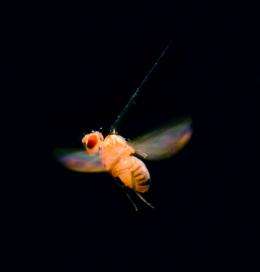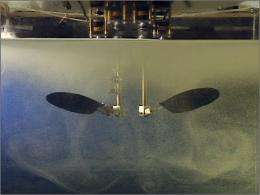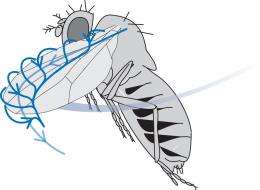Micro flying robots can fly more effectively than flies

There is a long held belief among engineers and biologists that micro flying robots that fly like airplanes and helicopters consume much more energy than micro robots that fly like flies. A new study now shows that a fly wing that spins like a helicopter blade generates the same amount of lift as a flapping fly wing while consuming only half the energy to move the wing. This finding can inspire the design of efficient micro flying robots with spinning fly-like wings.
Engineers have long been stymied in their attempts to fabricate micro aerial robots that can match the amazing flight capabilities of nature’s most advanced flying insects -- flies. Such robot flies -- if they could be made efficient enough for long missions -- could be used for a variety of tasks, from spying, to mine detection to search and rescue missions in collapsed buildings.

There is a long held belief among engineers and biologists that micro flying robots that fly like airplanes and helicopters consume much more energy than micro robots that fly like advanced insects such as flies. The previous thinking was that basic flapping wings at the small scale of insects waste less energy while generating lift. This idea, which has become integral to the development of fly-sized flying robots, now has been tested rigorously by a Dutch aerospace engineer, David Lentink at Wageningen University (Netherlands), who joined forces with a leading expert on insect flight, biologist Michael Dickinson at the California Institute of Caltech.
Together they used a giant robot fly submerged in a tank of oil to test whether flies consume less energy to hover than a micro helicopter outfitted with a fly wing. To their surprise, they found that a spinning fly wing generated the same amount of lift as a flapping fly wing while consuming only half the energy to keep the wing moving. The study shows that robots that hover like flies can save up to 50% energy if they swing an insect wing around like a helicopter blade. This finding can result in new, more energy efficient micro flying robot designs inspired by both the effective wing shape of insects and the energy efficient spinning motion of helicopter blades.

Flapping wings waste a lot of energy accelerating the air back and forth,’ explains Lentink. "That is why spinning insect wings consume less energy than flapping wings." So what does all this mean for engineers keen on designing micro fliers? "Engineers have been thinking that fly sized flying machines would have to fly like a fly to be energy efficient," says Lentink, but he now realizes that is not the case. The reason being that both spinning and flapping insect wings can generate much more lift than predicted by aerodynamic theory -- up to twice as much. The extra lift is generated by a stable ’tornado-like’ vortex that runs parallel to the leading edge of the wing. This vortex lowers the pressure over the wing and sucks it upward, lifting the insect's weight into the air. It was already known that both spinning and flapping insect wings can generate such a lift boosting vortex.
The new work shows which wing motion generates high lift most effectively -- the insect wing that spins around similar to a helicopter blade. Nevertheless, we still have much to learn from flies, says Dickinson. These tiny animals have evolved into some of nature’s best fliers and whereas the micro batteries of humans can keep their fly-sized robots aloft for mere seconds or minutes, flies can fly effortlessly for hours. ‘With such an effective form of energy storage and motors, flies are much less dependent on energy efficiency than our best robot flies," says Dickinson> "We can still learn from nature how to improve our flying robot designs, but not without a better understanding of why flies fly so well."
More information:
Published on the 31th of July in two Research Articles in the Journal of Experimental Biology:
- Lentink, D. and Dickinson, M.H. (2009) Rotational accelerations stabilize leading edge vortices on revolving fly wings. J. Exp. biol. 16.
- Lentink, D. and Dickinson, M.H. (2009) Biofluidynamic scaling of flapping, spinning and translating fins and wings. J. Exp. biol. 16.
Provided by Wageningen University




















